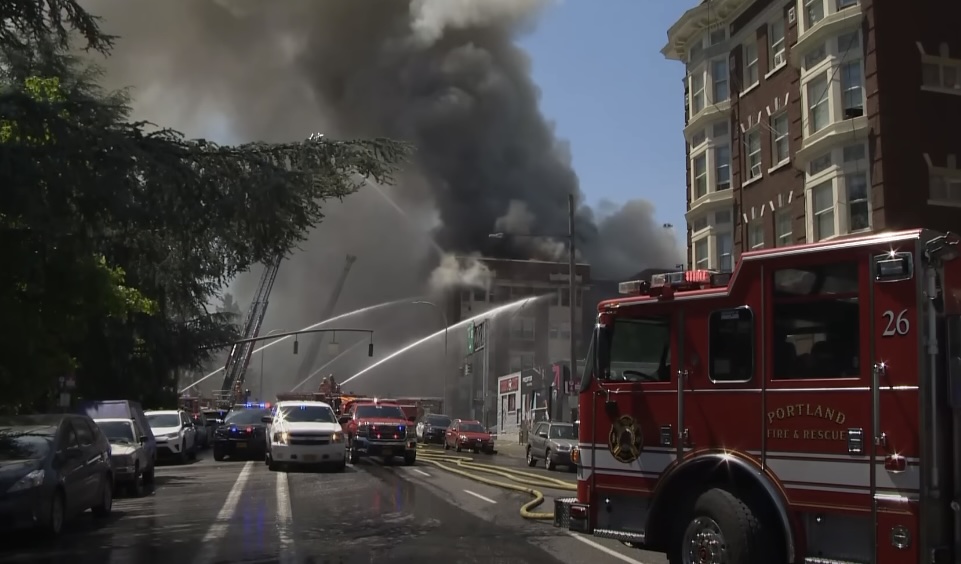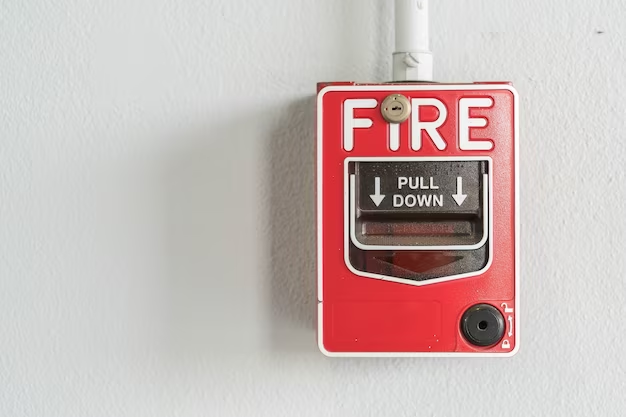The skyline of downtown Portland, Oregon, was dramatically altered one fateful night due to an apartment fire that captured the attention of the entire city. This incident wasn’t just another news story; it was a wake-up call regarding fire safety and community resilience. Let’s delve into the details of the apartment fire in downtown Portland, Oregon, and extract crucial lessons and preventive measures.
The Outbreak of the Fire

The downtown Portland, Oregon apartment fire began on an ill-fated evening, with the fire originating on one of the upper floors of a high-rise building. This incident occurred with sudden intensity, and the flames swiftly spread throughout the building, engulfing multiple floors within a matter of minutes. The residents and bystanders were left in a state of shock and disbelief as the fire raged on, casting a pall of darkness over the city.
First Response and Brave Efforts:
| Aspect | Description |
| Swift Response | Firefighters from various stations in Portland responded swiftly to the scene of the apartment fire. Their prompt arrival was crucial in containing the blaze and preventing it from spreading further. |
| Courageous Firefighters | The first responders exhibited tremendous courage and determination as they confronted the blazing inferno. They put their lives on the line to save others, entering the burning building and ascending multiple floors to rescue trapped residents. |
| Preventing Further Damage | One remarkable aspect of the response was the firefighters’ successful containment of the fire within the building where it originated. Their efforts ensured that the flames did not spread to nearby structures, preventing a potentially catastrophic situation. |
| Cooperation and Coordination | The effectiveness of the response was a result of the seamless coordination between multiple fire stations and emergency services. Teams worked in unison, deploying advanced firefighting equipment to battle the fire from various angles. |
| Rescues and Evacuations | Firefighters not only fought the flames but also conducted daring rescues and evacuations. They navigated through thick smoke and intense heat to save lives, ensuring that residents trapped on higher floors had a chance to escape to safety. |
| Support from the Community | The Portland community rallied behind the first responders, offering support in the form of water, food, and moral encouragement. This solidarity boosted the morale of the firefighters on the front lines. |
Impact and Aftermath
The apartment fire that occurred in downtown Portland, Oregon, had a significant impact on the community and the affected individuals. This article provides a detailed overview of the impact and the subsequent aftermath of the fire. The apartment fire in downtown Portland, Oregon, had several notable impacts:
- Property Damage: The fire caused extensive property damage, with estimates running into millions of dollars. This damage included the destruction of the apartment building itself, as well as damage to nearby structures and vehicles.
- Displacement of Residents: Many residents were forced to evacuate their homes due to the fire. This resulted in temporary displacement, with individuals and families needing immediate shelter and support.
- Economic Impact: The local economy also felt the repercussions of the fire. Businesses located in the vicinity of the fire were affected, leading to potential job losses and financial strain for those employed in the affected areas.
- Emotional and Psychological Impact: Apart from the physical damage, the fire had a profound emotional and psychological impact on the affected residents. The trauma of losing one’s home and belongings can have long-lasting effects on mental well-being.
- Community Mobilization: Despite the adversity, the fire had a unifying effect on the community. Local residents, businesses, and organizations rallied together to provide immediate assistance and support to those in need.
Community Response
The aftermath of the apartment fire in downtown Portland, Oregon, witnessed a heartwarming and robust response from the community. Here’s an in-depth look at the community’s actions and contributions:
| Assistance Category | Details of Assistance |
| Shelter and Housing Assistance | Local shelters and emergency housing facilities opened their doors to accommodate displaced residents. Residents generously offered spare rooms in their homes. Charitable organizations worked to secure safe and stable housing. |
| Donations and Fundraising | Local businesses initiated fundraising campaigns. Donation drives collected essential items. Monetary donations were received from various groups to assist with immediate needs and long-term recovery. |
| Emotional Support | Counseling services and support groups were established. Neighbors and friends offered a listening ear and companionship. |
| Food and Basic Necessities | Community members and local restaurants provided hot meals and food supplies. Food banks and relief organizations ensured access to essential groceries and supplies. |
| Assistance with Documentation and Claims | Volunteers assisted with paperwork for insurance claims and legal processes. Legal aid organizations offered pro bono services for navigating compensation procedures. |
| Long-Term Recovery | Community organizations and government agencies developed a comprehensive recovery plan. Efforts focused on rebuilding physical structures and revitalizing community spirit and economy. |
Fire Safety Measures

Fire safety is a crucial aspect of apartment living, and it is essential to take proactive measures to prevent fires and protect yourself and others in the event of an emergency. This guide will walk you through various fire safety measures, emphasizing the importance of regular inspections, smoke detectors, and fire extinguishers.
Regular Inspections: Complying with Fire Safety Standards
One of the fundamental aspects of fire safety in your apartment is ensuring that it meets all the required fire safety standards. Regular inspections are key to identifying and rectifying potential hazards. Here are some key points to consider:
| Safety Measure | Details |
| Check fire exits | Ensure that all fire exits in your building are accessible and free from obstructions |
| Maintain electrical systems | Regularly inspect and maintain your apartment’s electrical systems to prevent short circuits and electrical fires |
| Clear fire escape routes | Keep hallways and corridors clear to ensure safe evacuation in case of a fire |
| Ensure fire-resistant materials | Verify that your apartment uses fire-resistant building materials as per local regulations |
Smoke Detectors: Early Warning Systems
Smoke detectors are critical in providing an early warning of a fire. Proper installation and regular checks are essential to ensure they are functioning correctly. Here’s what you need to know:
- Installation: Place smoke detectors in key areas of your apartment, such as the kitchen, bedrooms, and hallways. Follow the manufacturer’s recommendations for placement.
- Testing: Test your smoke detectors monthly by pressing the test button. Ensure that the alarm sounds loud and clear.
- Battery Replacement: Change the batteries at least once a year or as soon as you hear the low-battery warning beep.
- Interconnected Detectors: If possible, connect smoke detectors in your apartment to create a network where all alarms go off when one detects smoke.
Fire Extinguishers: Your First Line of Defense
Fire extinguishers can be your first line of defense against small fires before they escalate. It’s crucial to have them accessible and know how to use them correctly:
| Fire Extinguisher Type | Suitable for | How to Use |
| ABC Fire Extinguisher | Most common, for general use | 1. Pull the pin. 2. Aim at the base of the fire. 3. Squeeze the handle. 4. Sweep from side to side. |
| CO2 Fire Extinguisher | Electrical fires | Similar steps as above, but do not touch the discharge horn as it gets extremely cold. |
| Water Mist Fire Extinguisher | Cooking oil fires, but not suitable for electrical fires | Similar to ABC extinguishers, but safe for grease fires. |
Remember, fire extinguishers should be placed in easily accessible locations and regularly inspected to ensure they are not expired or damaged.
Emergency Preparedness
Alt: Fire evacuation plan
In a bustling urban environment like downtown Portland, Oregon, it’s essential to be well-prepared for emergencies, especially fire-related incidents. This guide will provide detailed information on how to enhance your emergency preparedness, including the importance of an evacuation plan, maintaining a list of emergency contacts, and staying informed about fire-related news.
Evacuation Plan: Familiarize Yourself with the Building’s Evacuation Plan
In the event of a fire or any other emergency, knowing how to safely evacuate your building can be a lifesaver. Here’s how you can create and execute an effective evacuation plan:
| Evacuation Plan Steps | Details |
| Building Layout | Study the layout of your building, identifying primary and alternative escape routes. |
| Meeting Points | Designate a safe meeting point outside the building where all occupants should gather after evacuating. |
| Exit Signs | Ensure that all exit signs are well-lit and visible. Familiarize yourself with the locations of exits on each floor. |
| Fire Drills | Participate in fire drills organized by your building management to practice evacuation procedures and increase familiarity. |
Emergency Contacts: Compilation of Essential Information
Having a list of emergency contacts readily available is crucial. Include local emergency services, friends, family, and building management. Ensure that you and your loved ones can be reached swiftly in an emergency:
| Emergency Contacts | Details |
| Local Fire Department | Dial 911 for immediate assistance in the event of a fire or other emergencies. |
| Building Management | Save the contact information for your building’s management for updates on building safety. |
| Friends and Family | Ensure your loved ones are on your contact list, so you can quickly check on their safety. |
Stay Informed: Monitoring Fire-Related News
Staying informed about fire-related news in downtown Portland is essential for proactive emergency preparedness. Here are ways to keep yourself updated:
- Local News: Regularly follow local news outlets for updates on any fire incidents or safety advisories in the area.
- Weather Alerts: Be aware of weather conditions, as droughts and high temperatures can increase the risk of wildfires.
- Emergency Alerts: Sign up for local emergency alert systems or apps that provide real-time notifications about emergencies.
Conclusion
The apartment fire in downtown Portland, Oregon, was not just an isolated event, but a clarion call for heightened awareness and preparedness against such disasters. It highlighted the significance of community solidarity and the indomitable spirit of Portland’s residents and emergency services. Let this incident be a reminder to prioritize safety and stay vigilant, ensuring that the heart of Portland remains a safe and thriving community.
FAQ
Q: What caused the apartment fire in downtown Portland, Oregon?
A: Investigations are ongoing, but initial reports suggest it might have been due to an electrical fault.
Q: Were there any casualties in the downtown Portland Oregon apartment fire?
A: No casualties were reported, thanks to the swift evacuation and response by the fire department.
Q: How can I contribute to help the victims of the downtown Portland Oregon apartment fire?
A: You can donate to local charities or volunteer your time to help the displaced residents.
Q: What should I do if I notice a fire hazard in my apartment building in downtown Portland, Oregon?
A: Report it immediately to your building management and the local fire department.